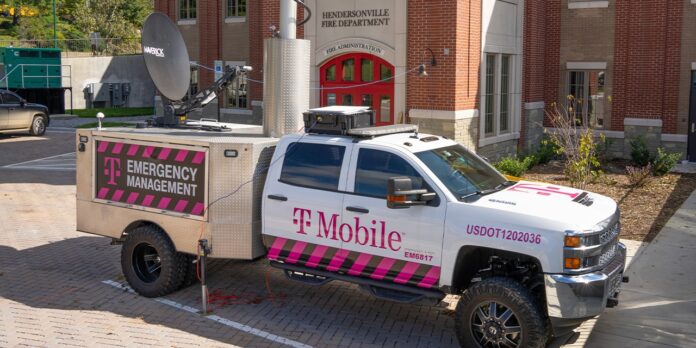The direct-to-cellular service is pre-commercial, but it has been activated in parts of North Carolina to help the hurricane recovery effort
The Federal Communications Commission has given permission for T-Mobile US and Elon Musk’s Starlink LEO satellite service to offer direct-to-cellular service to T-Mobile US customers in parts of North Carolina as part of the ongoing response to Hurricane Helene.
The storm devastated communications across multiple Southeastern states, with recovery going particularly slowly in the rural, mountainous areas of the Carolinas and Georgia where roads and bridges have been washed out or destroyed.
“While SpaceX’s direct-to-cell constellation has not been fully deployed, we felt that getting even this early test version into the hands of people on the ground could provide vital support as teams work to get infrastructure and services back online and help first responders with rescue efforts,” T-Mobile US said in an online update confirming that it had received Special Temporary Authority (STA) from the FCC for the direct-to-device service.
“The satellites have already been enabled and started broadcasting emergency alerts to cell phones on all networks in North Carolina,” SpaceX said in a post on X, formerly Twitter, on Sunday afternoon. “In addition, we may test basic texting (SMS) capabilities for most cell phones on the T-Mobile network in North Carolina. SpaceX’s direct-to-cell constellation has not been fully deployed, so all services will be delivered on a best-effort basis.”
The FCC responded to SpaceX’s post from its official account with its own post, saying: “We remain committed to helping with recovery efforts in states affected by Hurricane Helene. We stand ready to do all that is necessary to return connectivity to hard-hit areas and save lives.”
Satellite connectivity is already part of the restoration response for terrestrial telecom networks, with all of the national network operators deploying a wave of portable cellular sites in various form factors from trucks and trailers to drones, with satellite-connected backhaul, to provide temporary coverage for the public and first responders. But being able to offer satellite-based connectivity for members of the public or first responders to access via their smartphones brings a new dimension to the disaster response, particularly in the remote and rugged territory where the lack of cellular service is still hampering the recovery efforts.
The FCC put new rules in place earlier this year to enable direct-to-cellular service from satellites, which it calls Supplemental Coverage from Space or SCS.
T-Mobile US said on Sunday that its network is “almost fully restored along affected regions, with less than 1% of network sites in specific areas where conditions remain particularly challenging not connected. We continue our efforts to support these communities.”
North Carolina continues to be the hardest-hit state in terms of infrastructure impacts as well as the human toll. Of the more than 225 deaths confirmed thus far, about half occurred in North Carolina. According to the FCC’s most recent figures reported by mobile network operators, the state still has nearly 20% of the sites out in the affected areas. In Buncombe County, which includes Asheville, N.C., there are still 90 sites out or 25% of the total sites serving the county. Only one site was reported as out due to physical damage, the rest were down due to lack of power or backhaul. Other North Carolina counties with a high percentage of sites still out include Henderson (31% of sites still out), Mitchell (half of the county’s 20 sites are out) and Yancey (16 of the county’s 22 sites are out).

